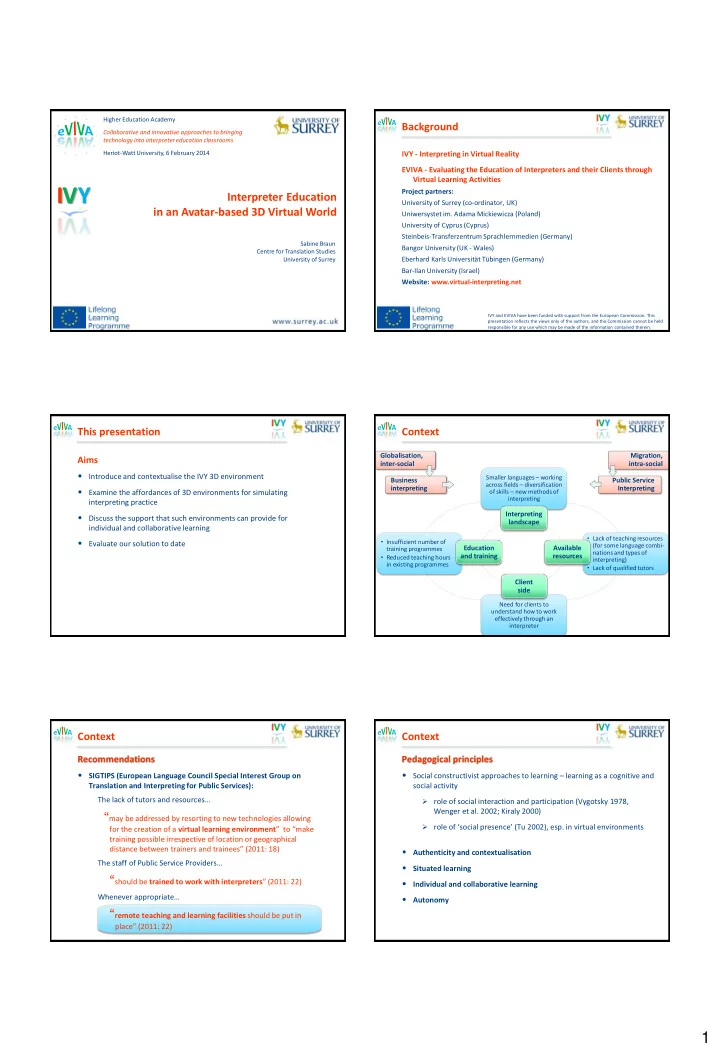

Higher Education Academy Background Collaborative and innovative approaches to bringing technology into interpreter education classrooms Heriot-Watt University, 6 February 2014 IVY - Interpreting in Virtual Reality EVIVA - Evaluating the Education of Interpreters and their Clients through Virtual Learning Activities IVY Project partners: Interpreter Education University of Surrey (co-ordinator, UK) in an Avatar-based 3D Virtual World Uniwersystet im. Adama Mickiewicza (Poland) University of Cyprus (Cyprus) Steinbeis-Transferzentrum Sprachlernmedien (Germany) Sabine Braun Bangor University (UK - Wales) Centre for Translation Studies University of Surrey Eberhard Karls Universität Tübingen (Germany) Bar-Ilan University (Israel) Website: www.virtual-interpreting.net IVY and EVIVA have been funded with support from the European Commission. This presentation reflects the views only of the authors, and the Commission cannot be held responsible for any use which may be made of the information contained therein. This presentation Context Globalisation, Migration, Aims inter-social intra-social • Introduce and contextualise the IVY 3D environment Smaller languages – working Business Public Service across fields – diversification interpreting Interpreting • Examine the affordances of 3D environments for simulating of skills – new methods of interpreting interpreting practice Interpreting • Discuss the support that such environments can provide for landscape individual and collaborative learning • Lack of teaching resources • Insufficient number of • Evaluate our solution to date (for some language combi- Education Available training programmes nations and types of and training resources • Reduced teaching hours interpreting) in existing programmes • Lack of qualified tutors Client side Need for clients to understand how to work effectively through an interpreter Context Context Recommendations Pedagogical principles • SIGTIPS (European Language Council Special Interest Group on • Social constructivist approaches to learning – learning as a cognitive and Translation and Interpreting for Public Services): social activity The lack of tutors and resources… role of social interaction and participation (Vygotsky 1978, Wenger et al. 2002; Kiraly 2000) “ may be addressed by resorting to new technologies allowing role of ‘social presence’ ( Tu 2002), esp. in virtual environments for the creation of a virtual learning environment ” to “make training possible irrespective of location or geographical distance between trainers and trainees” (2011: 18) • Authenticity and contextualisation The staff of Public Service Providers… • Situated learning “ should be trained to work with interpreters ” (2011: 22) • Individual and collaborative learning Whenever appropriate… • Autonomy “ remote teaching and learning facilities should be put in place” (2011: 22) 1
Context IVY: Interpreting in Virtual Reality 3D Virtual Learning Environments Initial assumptions – what can they offer for interpreter training: • Options for participation, immersion, simulation and interaction • Media-rich and user-created content • ‘Augmented’ capabilities (exploration from different perspectives) The virtual world • Preparation for future professional practice (digital literacy) • A virtual island and scenarios: the 3D Satisfy social and cognitive constructivist principles space with buildings and other objects • Avatars & robots: user/speaker IVY: an avatar -based multi-user 3D virtual environment to representation simulate interpreting practice • Tools, incl. HUD, voice chat, audio based on successful prior uses in different educational contexts (e.g. player etc.: simulation and practice Calongne 2008, Collins 2008, Peachey et al. 2010, Savin-Baden et al. 2010) (Braun et al. 2013, Ritsos et al. 2013) IVY: Interpreting in Virtual Reality IVY: Interpreting in Virtual Reality Practice with prepared material • Monologues and bilingual dialogues based on spoken corpora, Practice with prepared material (BACKBONE and ELISA corpora) Individual learning Authenticity IVY: Interpreting in Virtual Reality IVY: Interpreting in Virtual Reality German – English dialogue between a journalist from Practice with prepared material Germany and the Director of Trading of the • Embedded in virtual scenarios, with University of Surrey. The journalist is writing an robots as ‘speakers’; briefings for article about the concept of ‘fair trade’ and has come to the University of Surrey to talk to the University’s interpreting practice Director of Trading about the University and about Situated learning the University’s Fairtrade status. 2
IVY: Interpreting in Virtual Reality IVY: Interpreting in Virtual Reality Live role play • Live interaction with others, including potential clients Live role play Authenticity Collaborative learning IVY: Interpreting in Virtual Reality Recap What’s in IVY What can users do in IVY? Practise interpreting Prepare for Individual learning: in real time interpreting Work with prepared Train practice content individual interpreting skills Reflect upon 3D virtual world with aspects of Learn interpreting scenarios interpreting about inter- Simulate preting interpreted Live role play events Collaborative learning: • Simulation of interpreter- live role play Explore interpreting … mediated events problems • Embedded in virtual scenarios But can they? Situated learning Evaluating the IVY environment Evaluating the IVY environment • Functional dimension : does the system design support the learning – Challenges as a prerequisite • How to evaluate whether the VLE helps achieve this, i.e. how to isolate Academic debate: how much is needed the contribution of the VLE? (see also Hansen & Shlesinger 2007) Sense of presence Usability, user experience (‘would you recommend it…’) • Complementarity problem : blended learning – learning success But: do learners know what is good for them emerges as a combination of all activities/resources • Pedagogical dimension • Time factor : learning takes time – difficult to observe and evidence Evaluating the product (what has been learnt) – not helpful here, • Ethical/practical difficulties : experimental design – hard to achieve in given the problems with isolation practice and ethically problematic in student group Evaluating the process – how do learners interact with the environment in the pursuit of their aims – i.e. do we see evidence that the environment supports the stated pedagogical Multidimensional evaluation, mixed methods principles 3
Recommend
More recommend